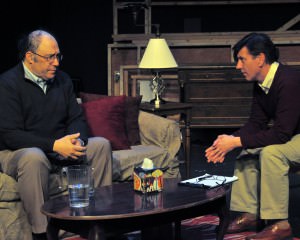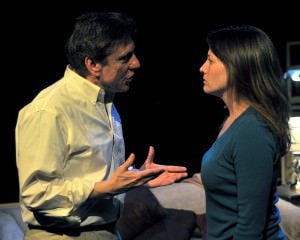Some Shining Moments in Shining City
Irish playwright Conor McPherson’s Shining City is a beautiful, poignant play with an almost preternatural ring of truth to it. Upon seeing the original production of it in London, the reviewer for the Daily Telegraph pronounced McPherson “the finest dramatist of his generation.” Watching a performance of the writer’s work, and this play in particular, makes that ostensibly outrageous declaration seem downright reasonable. In fact, one would be hard-pressed to contest it.
The Capital City Players of Washington, DC capably brought McPherson’s play to life on Friday night with the opening performance of the production’s three-weekend run. Directed and produced by David Dieudonne in the tiny black-box theatre of the Capitol Hill Arts Workshop, this version of Shining City quickly pulls the audience into a story that is at once ordinary and fascinating.

When critics write about Shining City they often extoll the power and eloquence of its silences. That’s a well-deserved accolade. McPherson masterfully gives his audience just enough information to enable it to hear and comprehend what his characters leave unspoken.
Less commonly remarked, however, is the extraordinary amount of story and feeling that is expressed verbally in this play. The honesty and detail with which the character John tells his tale make his lengthy speeches riveting. McPherson’s greatest talent as a writer – and he has many -might be the patience, persistence, and artistic courage with which he allows a story to unfold, often in lengthy monologues that other writers would shrink from, wisely if they lack McPherson’s skill, as most do.
Ian, a therapist, is the central character of Shining City. He has recently set up shop in a Dublin walkup with inadequate amenities. John, a new patient, has been wracked with grief since the death of his wife in a car accident. Of greater concern is the fact that he has seen her ghost in their house on more than one occasion and consequently has been unable to live there.
John tells his story, almost uninterrupted by Ian, in a series of visits to the office. In between these therapy scenes, we learn more about the ex-priest Ian, who is arguably more in need of therapy than John. First we see Ian arguing with his girlfriend, from whom he is estranged, a condition he is determined to make permanent. Later, he brings a young prostitute to his office, in an awkward, anxiety-ridden effort to finally act on his homosexual inclination.
In the CCP production Ted Schneider is captivating as John, skillfully leading the audience through his alternately funny, sad, cringe-inducing, and ultimately unsuccessful foray into the world of extramarital sex. His ability to convey the character’s guilt and regret is most impressive. When he describes his unprovoked verbal attack on his wife, we want to cry for both of them.
James Raby, as Ian, is clearly well rehearsed and plays his part with authority. But his Ian is high-strung, jumpy, sometimes angry, and always loud. Any prospective patient would walk the other way after spending a minute in the presence of this ball of nerves. In this role, the highly accomplished and renowned Raby lacks the subtlety necessary to allow the audience to see inside of him while plausibly withholding that view from the other characters.
Ashley Kelly plays Ian’s girlfriend Neasa with a nice mix of strength and vulnerability. In one brief scene, she ably expresses a wide array of emotions. Robert Burden makes his theatrical debut as Laurence, the prostitute. It is clear that Burden lacks theatrical education and experience, but he shows solid promise and should be encouraged to do more.
One prominent failing of the entire cast, and presumably of dialect coach Mary Macfarlane, is the inability to speak in Irish accents. Schneider’s otherwise excellent performance was slightly marred each time he had to use a U.K. expression, such as “your man” or “arse-backward.” Kelly comes the closest to believability with her dialect, but even she has trouble with consistency.
The cast also has difficulty with the hyper-realistic speech patterns of McPherson’s characters, replete with “you knows” and many incomplete thoughts and sentences. This came off wonderfully in Schneider’s monologues, but almost all of the dialogue seemed studied in that regard and failed to achieve the naturalistic effect intended.
The simple set, designed by Macfarlane and built by Steve Leshin, served its purpose in cramped quarters. It was jarring, however, for one wall to be absent, replaced by a black curtain. It becomes clear eventually why this choice was made, but the designers should have come up with a more clever way to bring about a certain special effect. Said effect — which would be spoiled if described further here — was diminished by an actor becoming visible to part of the audience too early.
Lighting Designer Peter Caress achieved the goal of every lighting designer of this sort of play: No one noticed or talked about the lighting. Sound Designer Jamie Coupar provided appropriately haunting music during scene changes. But lack of volume on an important sound cue further hampered the aforementioned special effect.

The set dressing and props, also Mcfarlane’s charge, suited the play well. One very noticeable problem, however, was a gift given by one character to another late in the show. He carried in a large, open, unwrapped cardboard box, in which the gift seemed to have been carelessly thrown. Another problem that will hopefully be remedied soon is the poor coordination of the scene changes. They were sometimes excruciatingly slow and noisy.
Dieudonne’s staging of the script was appropriately straightforward and gimmick-free. One oddity of the play’s blocking was that when the two men meet for the last time, they are uncomfortably close to each other. It’s not clear whether this was accidental or meant to signify something about the moment.
CCP’s production of Shining City has some wonderful moments and more than a few flashes of great acting. The company should be proud of its success in tackling such difficult material in a challenging space.
Featured Picture: The Capital City Players’ logo.
Shining City plays through March 24, 2012, at The Capital City Players in The Blackbox at Capitol Hill Arts Workshop (CHAW) – 545 7th St SE, in Washington, DC. Purchase tickets online.




